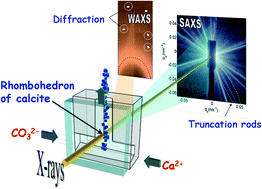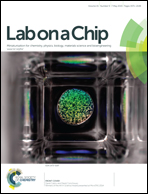Implementation of in situ SAXS/WAXS characterization into silicon/glass microreactors†
Abstract
A successful implementation of in situ X-ray scattering analysis of synthetized particle materials in silicon/glass microreactors is reported. Calcium carbonate (CaCO3) as a model material was precipitated inside the microchannels through the counter-injection of two aqueous solutions, containing carbonate ions and calcium ions, respectively. The synthesized calcite particles were analyzed in situ in aqueous media by combining Small Angle X-ray Scattering (SAXS) and Wide Angle X-ray Scattering (WAXS) techniques at the ESRF ID02 beam line. At high wavevector transfer, WAXS patterns clearly exhibit different scattering features: broad scattering signals originating from the solvent and the glass lid of the chip, and narrow diffraction peaks coming from CaCO3 particles precipitated rapidly inside the microchannel. At low wavevector transfer, SAXS reveals the rhombohedral morphology of the calcite particles together with their micrometer size without any strong background, neither from the chip nor from the water. This study demonstrates that silicon/glass chips are potentially powerful tools for in situ SAXS/WAXS analysis and are promising for studying the structure and morphology of materials in non-conventional conditions like geological materials under high pressure and high temperature.


 Please wait while we load your content...
Please wait while we load your content...